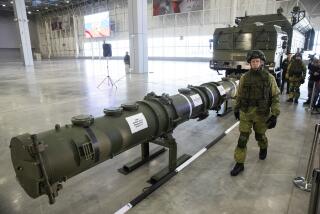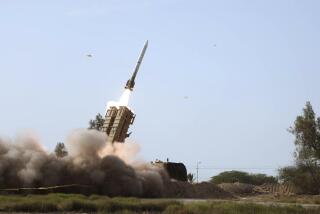One-Upmanship on Missiles?
Until lately the Administration’s arms-control strategy was supposed to be based on the thesis that, for the sake of a safer and more stable nuclear balance, the Soviet Union should be encouraged to join the United States in moving toward survivable, single-warhead missiles. Now President Reagan has decided to change scripts.
In his most recent arms-control proposal he included an offer to negotiate a ban on mobile, land-based intercontinental ballistic missiles. Such a ban would require the United States to abandon its development program for the so-called Midgetman. The Soviets would have to give up their SS-24 and SS-25 mobile ICBM programs.
A case can be made for the switch. But a policy change of this magnitude should not be made without serious consideration of the consequences.
Arms-control specialists in and out of government generally agree that too much emphasis on fixed-base, multiple-warhead missiles is an inherently dangerous and unstable situation. Such missiles, in the hands of the other side, look suspiciously like first-strike weapons. In one’s own arsenal their vulnerability invites a use-them-or-lose-them mentality if the adversary is perceived to be preparing for attack.
The balance of nuclear terror would be more stable, and less prone to hair-trigger escalation, if the warheads on each side were scattered among a greater number of survivable missiles. This reasoning was embodied in the Scowcroft Commission’s recommendation two years ago for (1) limited U.S. deployment of big, multiple-warhead MX missiles to offset existing weapons of that sort on the Soviet side; (2) eventual deployment of a much larger number of mobile, single-warhead Midgetman missiles, and (3) negotiations aimed at persuading Moscow to make a similar shift to smaller, single-warhead ICBMs.
The approach was accepted by the Administration and approved by key members of Congress. Now the President has abruptly switched signals.
A mobile-missile ban does have its attractions.
To begin with, it is one thing to have mobile, easy-to-hide ICBMs on both sides and quite another if the Soviets have them and we don’t. The U.S. Midgetman is still in the design stage; it isn’t scheduled for deployment until 1992. The Soviets, on the other hand, have already begun deploying the SS-25 and are believed close to deployment of the SS-24: both are designed to be mobile.
Furthermore, the Administration cannot be sure that the Midgetman will ever be deployed, considering the cost in money and manpower and the inevitable political opposition in the Western states where the missiles would be based.
Moscow is already building a mobile, survivable ICBM force that will add to its theoretical first-strike capability, and whose numbers will be difficult to verify. Aside from submarine-fired missiles, we have nothing comparable. So if the Soviets can be persuaded to cut a deal on such weapons, why not?
The answer is reflected in retired Gen. Brent Scowcroft’s comment that U.S. nuclear policy “is in a state of strategic disarray.” If a shift by both sides toward smaller, more survivable missiles is no longer a negotiating goal, it isn’t clear what the U.S. arms-control strategy really is.
The experts point out that major cuts in the numbers of nuclear weapons, as proposed by both Reagan and Soviet leader Mikhail S. Gorbachev, could actually increase rather than reduce the danger of nuclear war unless the reductions are carefully structured to avoid creating a new imbalance at a lower numerical level.
It may be that, when the pros and cons are weighed, the President’s offer on mobile missiles was a good move. But there’s a disquieting impression that the proposal had more to do with pre-summit one-upmanship than with cool analysis of the trade-offs involved.
More to Read
Sign up for Essential California
The most important California stories and recommendations in your inbox every morning.
You may occasionally receive promotional content from the Los Angeles Times.










